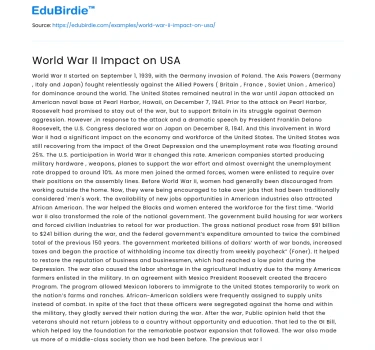World War II started on September 1, 1939, with the Germany invasion of Poland. The Axis Powers (Germany , Italy and Japan) fought relentlessly against the Allied Powers ( Britain , France , Soviet Union , America) for dominance around the world. The United States remained neutral in the war until Japan attacked an American naval base at Pearl Harbor, Hawaii, on December 7, 1941. Prior to the attack on Pearl Harbor, Roosevelt had promised to stay out of the war, but to support Britain in its struggle against German aggression. However ,in response to the attack and a dramatic speech by President Franklin Delano Roosevelt, the U.S. Congress declared war on Japan on December 8, 1941. And this involvement in Word War II had a significant impact on the economy and workforce of the United States.
The United States was still recovering from the impact of the Great Depression and the unemployment rate was floating around 25%. The U.S. participation in World War II changed this rate. American companies started producing military hardware , weapons, planes to support the war effort and almost overnight the unemployment rate dropped to around 10%. As more men joined the armed forces, women were enlisted to require over their positions on the assembly lines. Before World War II, women had generally been discouraged from working outside the home. Now, they were being encouraged to take over jobs that had been traditionally considered 'men's work.
The availability of new jobs opportunities in American industries also attracted African American. The war helped the Blacks and women entered the workforce for the first time. “World war II also transformed the role of the national government. The government build housing for war workers and forced civilian industries to retool for war production. The gross national product rose from $91 billion to $241 billion during the war, and the federal government’s expenditure amounted to twice the combined total of the previous 150 years. The government marketed billions of dollars’ worth of war bonds, increased taxes and began the practice of withholding income tax directly from weekly paycheck” (Foner). It helped to restore the reputation of business and businessmen, which had reached a low point during the Depression.
The war also caused the labor shortage in the agricultural industry due to the many Americas farmers enlisted in the military. In an agreement with Mexico President Roosevelt created the Bracero Program. The program allowed Mexican laborers to immigrate to the United States temporarily to work on the nation’s farms and ranches. African-American soldiers were frequently assigned to supply units instead of combat. In spite of the fact that these officers were segregated against the home and within the military, they gladly served their nation during the war. After the war, Public opinion held that the veterans should not return jobless to a country without opportunity and education. That led to the GI Bill, which helped lay the foundation for the remarkable postwar expansion that followed. The war also made us more of a middle-class society than we had been before.
The previous war like Mexican war and world war had deeply divided American society where as world war II brought together by encouraging the patriotism. World war II remembered as the Good war. World war II created a vast melting pot, especially for European immigrants and their children. The wartime economy presented women and minorities with new job opportunities. Although the war presented Americans with new opportunities, American society was still plagued by social issues such as racial tensions and discrimination.






 Stuck on your essay?
Stuck on your essay?

